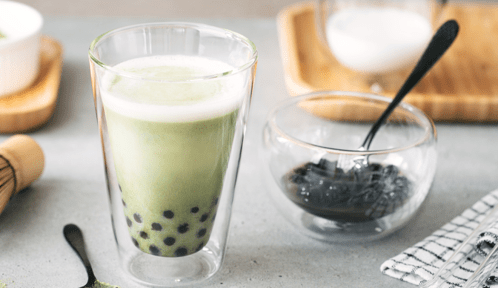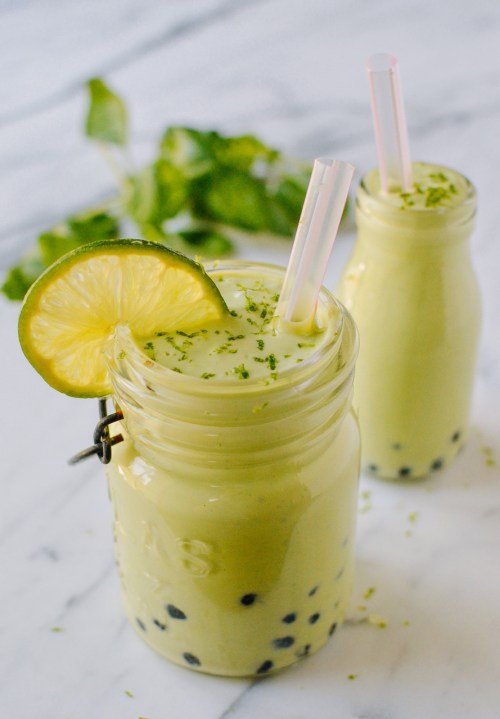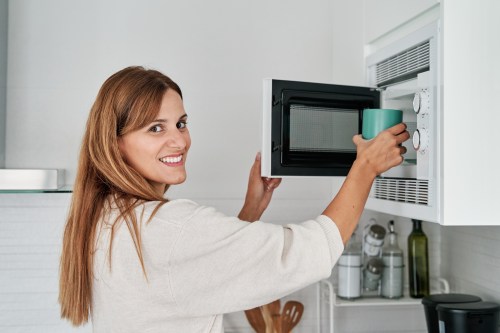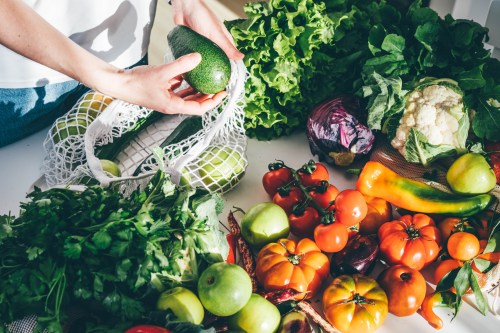Our editors independently select these products. Making a purchase through our links may earn Well+Good a commission
This 5-Ingredient Boba Tea Avocado Smoothie Recipe Sparks Springtime Joy With Every Sip
Learn how to make this simple five-ingredient avocado boba smoothie recipe that’ll spark joy with every sip.

Springtime is officially here, which can only mean one thing: Outdoor hot girl walks are resuming, and they’re not complete without a refreshing iced-cold beverage in hand. What’s on the menu this week? Boba tea (…obviously). The Taiwanese beverage that stars sweet, plush tapioca “bubbles” brings joy and refreshment with every sip, and it’s one of our favorite drinks to sip while getting a healthy dose of vitamin D from the sun’s rays.
Experts in This Article
blogger at The Woks of Life
To learn more about the roots of boba tea (aka bubble tea), we recently caught up with Sarah Leung and Kaitlin Leung, who, along with their parents Bill and Judy, are the creators behind the popular family-operated recipe and lifestyle blog, The Woks of Life, which has become an online authority on Chinese cooking. The Leungs are the authors of the New York Times bestseller, The Woks of Life Cookbook, which features 100 of their favorite home-cooked and restaurant-style Chinese recipes. What’s more, the duo shared a delicious boba tea avocado smoothie recipe with us that might just be the best variation of the drink we’ve ever heard. No, you’re drooling.
A little background history on boba tea
First things first, the Leungs share a bit of history regarding one of the most popular drinks across Asia. “Boba, also known as tapioca pearls or tapioca balls, are chewy, sweet balls made from tapioca starch, and while they’re used in various desserts across Asia—bilo-bilo in the Philippines or baobing shaved ice desserts in China, for instance—they are most well-known for their use in bubble tea,” the Leung siblings say. According to them, it’s believed that bubble tea originated in Taiwan around the late 1980s. In its original form, bubble tea was a sweet milk tea drink with boba, although the Leungs say you can find tons of variations these days, from tea-based and fruit-based bubble tea options.
“Boba, also known as tapioca pearls or tapioca balls, are chewy, sweet balls made from tapioca starch, and while they’re used in various desserts across Asia—bilo-bilo in the Philippines or baobing shaved ice desserts in China, for instance—they are most well-known for their use in bubble tea,” the Leung siblings say.
According to the Leungs, boba tea began appearing stateside in the 1990s. “We noticed bubble tea shops popping up around Chinatown when we were young. I knew it had reached a new level of popularity when I was on a school trip in Boston in eighth grade, and I ordered a bubble tea while visiting Faneuil Hall and all my classmates rushed up to me asking what it was and where I’d gotten it,” Leung says.
What was the inspiration behind the boba avocado smoothie recipe?
As the Leung sisters mentioned, many adaptations of boba tea have emerged over the years—and their boba avocado smoothie recipe is a prime example. “The idea for this smoothie actually came from a family friend from Brazil, who told us that she used to make smoothies with avocados—her parents had an avocado tree in their yard—lime, and sweetened condensed milk. It sounded delicious, so we tried it, and it was, indeed, really tasty,” Leung says.
“The idea for this smoothie actually came from a family friend from Brazil, who told us that she used to make smoothies with avocados—her parents had an avocado tree in their yard—lime, and sweetened condensed milk. It sounded delicious, so we tried it, and it was, indeed, really tasty,” Leung says.
Around the time their family friend introduced them to the idea of an avocado smoothie, the Leungs noticed that bubble tea shops were coming out with all sorts of new flavors and boba smoothie combinations, too. “We decided to add boba to the avocado smoothie as a sort of Asian twist on the recipe,” Leung says. To nail the recipe, they suggest buying store-bought boba at a local Asian market, where it’s generally sold dried and can be either clear or dark brownish-black, depending on whether it’s made with brown sugar.
That said, the Leungs note that cooking with boba can be a little tricky. To learn ways to master cooking with ‘em, the Leungs point us to their detailed guide for cooking with tapioca pearls featured on their blog. The main takeaway? Ensure they’re cooked thoroughly. “Make sure that you cook them until they are completely translucent and no longer have an opaque center, which indicates the middle is still raw,” Leung says. “Letting the boba continue to sit in hot water after simmering can help the boba cook through gradually.”
Of course, boba tea avocado smoothies are downright delicious. However, if you’re looking for more ways to enjoy boba, the Leungs recommend trying their go-to baobing recipe, which is Chinese shaved ice. Yum.

Avocado boba smoothie recipe
Yields 4 servings
Ingredients
1/2 cup tapioca pearls (“bubbles” or “boba,” optional)1 cup ice1 avocado (pitted and scooped out in chunks)9 basil leaves1 lime (juiced and zested)1/2- 3/4 cup condensed milk (depending on your preferences for sweetness)1 cup water
1. Boil a small pot of water. Cook the tapioca pearls per package instructions. When they’re done, drain and transfer to a small bowl with a small amount of room temperature water so they don’t harden and dry out.
2. Next, prepare your smoothie. Pile the rest of the ingredients into your blender. Blend until smooth.
3. In a tall glass, add a 1/4 cup of tapioca pearls and pour your avocado smoothie over the top. Top with some additional lime zest if desired, add a straw, and enjoy!
Recipe courtesy of The Woks of Life.
An RD shares the benefits of consuming avocados:
Sign Up for Our Daily Newsletter
Get all the latest in wellness, trends, food, fitness, beauty, and more delivered right to your inbox.
Got it, you've been added to our email list.









